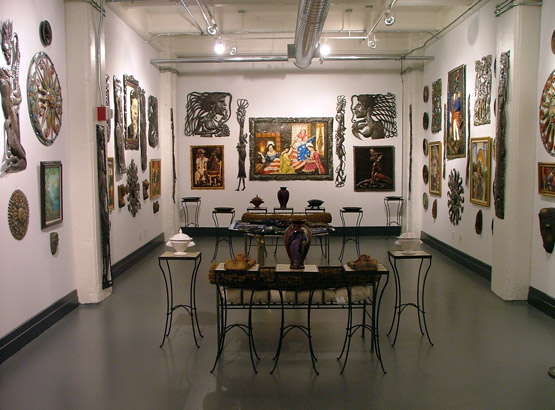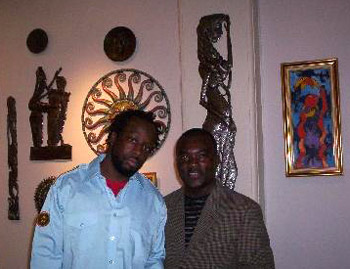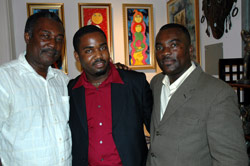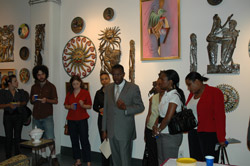An
Overview of Haitian Art
by Bernadette Deamico & Louis-Marc Lazarre |
Without a doubt,
Haitian Art is among the most appreciated in the world. It continues
to receive critical acclaim while at the same time enjoying some
measure of commercial success. Yet, that success comes with a history
of controversy, as Haitian artists, local and western critics have
dueled over what form of artistic expression is more authentic and
therefore worthy of consideration as characteristic Haitian art.
Clearly there is a strong record of artistic activity predating
1940. Haitian artists did not learn how to paint out of the blue,
or through the intervention of some foreigners, but rather displayed
an influence by traditions that go way back and have a good body
of work to show for it. However, it’s in the 1940s that the
world outside of Haiti begins to take notice.
In the 1940s, Dewitt Peters, an American schoolteacher, arrived
in Haiti. Almost immediately he was stricken by the raw artistic
talent displayed by many untrained and in many cases uneducated
painters he would encounter. Those were people who never went to
art school workers of all trades, who would come home and produce
marvels of ingenious art work. In 1944, he founded the Centre d’Art
in Port-au-Prince. |
 |
Haitian
Culture
Rich
in its history, people, art, music, and religion, Haitian Culture
is unique in the Caribbean. Visitors report that upon visiting,
you inevitably develop a love relationship with the country.
If you go there prepared with a little understanding of its
history and culture, we are certain you will surely be connected
in more ways than you can imagine. Like magic. |
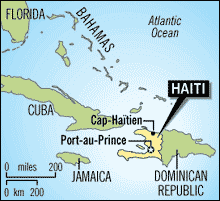 |
|
| The Centre d’Art became the champion of the art form that would
be known as “Naïve Art”, “peinture naïve”
or better called “intuitive art”. Intuitive painting is
characterized by vivid, raw colors, a spatial composition and use
of proportions that did not abide by any of the modern laws aesthetics,
but rather revealed spontaneity, freedom of expression and freshness.
That art form would attain notoriety on the world scale, especially
with the arrival of co-director Selden Rodman. Selden Rodman rejected
modernism, the leading art movement of the time, being too post-war,
too vanguard and therefore too socially inclined. Contrarily to what
many manuals wrote, though, neither the Centre D’Art nor Dewitt
Peters invented Naïve Art. Nevertheless, they are credited for
their efforts in having brought it to the attention of the Western
World. The primitives of the first generation received worldwide acclaim.
Critics and collectors received the movement as “authentic”
and “unspoiled”. The main heroes of that movement were otherwise
common, non-artistically trained folks who had great talent. They
were Andre Pierre, Hector Hippolyte, Castera Bazile, Wilson Bigaud,
and Rigaud Benoit (b. 1911). Voodoo was prominently featured in the
works of those artists. Andre Pierre and Hippolyte themselves were
voodoo priests.
The Primitive
Movement was accompanied by great controversy. Many other Haitian
artists, the intelligentsia and the elite alike resented the seal
of authenticity attached to Naïve Art. Why would only unschooled
artists be recognized as authentic Haitian artists? Even if for
the wrong reasons, the generally reactionary Haitian elite of the
time had a point. What gave Western critics the right to decide
what represents true Haitian Art? What gave the Centre d’Art
the mandate to act as arbitrator, championing one movement versus
others? Haitian painters to this day have to deal with the preconceived
notion that Haitian Art is supposed to resemble work from that era
for it to be authentic. Collectors attach high value to the works
of the masters from that era while eschewing the work of even accomplished
artists displaying more contemporaneous trends as being unrepresentative
of Haitian Art as critics conceive of it. Well, for better
or for worse, Intuitive Art and the Centre D’Art, became a
driving force behind the Haitian Art industry as a whole by bringing
worldwide attention towards the small nation. The Centre d’Art
gave a chance to painters who otherwise would never be noticed by
the conservative art establishment of the time. It allowed voodoo
artists like Hector Hippolyte and Andre Pierre to express themselves,
and made religious art more acceptable. It provided support and
a market for generations of painters and made international celebrities
out of many. Intuitive Art became very prized by tourists who kept
alive a whole industry, even when quality of the art work over the
years, especially what is found on the streets, became quite questionable.
Intuitive Art from the 50s and on became a cash crop that even the
elite in turn cultivated by buying the best of the genre for display
in posh galleries.
The Naïve Art Movement and the Centre d’ArtThere were many
offshoots to the Naïve movement. Philome Obin would create
the School of (Cap-Haitian) that included artists such as Seneque
Obin, his younger brother. Second generation of intuitive painters
include Gerard Valcin, Wilmino Domond, Gabriel Alix, and Prefete
Duffaut. The second generation is characterized by a certain departure
from the style of the original masters of the 40s. Many of those
artists would, through their travels, learn other techniques and
would use them to enrich and solidify their original style. Prefete
Duffaut is especially famous for his mountainous landscapes where
Heaven meets Earth and the laws of Gravity are nonexistent. Duffaut
would later create the School of Jacmel in the country’s Southeast.
Other primitives of the second generation are famous for their depictions
of jungles with lions and tigers in a local context, or oversized
fruits. The “Poto Mitan” (pole in the center of a hounfor,
a voodoo temple) School of 1968 shows renewed interests in Vaudou
and Pre-Hispanic themes. It featured artists such as Jean Claude
Garoute with adopted artist name “Tiga”, Maud Robart and
Patrick Vilaire. Tiga and Robart would be at the origin of what
was called the most striking experiment of magical painting ever
seen. That was the Saint Soleil experiment.In the early
70’s, Tiga and Robart, already famous painters who rejected
the prevalent primitive movement, wanted to create a community of
artists whose inspiration stemmed from pure unadulterated Haitian
sources. They bought a property in the mountains where they distributed
art materials to a group of peasants who have never painted to see
what would come out of it. The results were spectacular. The major
artists produced by that experiment include Louisiane St Fleurant,
Prospere Pierre Louis, Antilhomme, Levoy Exil and later on, Stevenson
Magloire, son of Louisiane. Andre Malraux, the famous French writer,
came to visit the workshop and was amazed at the results. He devoted
a whole chapter of his last book I’Intemporal to “Saint
Soleil” (Saint Sun), which is the name of the new experiment
with “Tiga” being the founding director. Success became
detrimental to “Saint Soleil”, part-time artists became
full-time artists and soon, as commercialism again ensued, the school
disbanded. Then Levoy Exil reorganized the group into “Cinq
Soleils” with Prosper Pierre Louis, Denis Smith, Dieuseul Paul
and Louisianne Saint-Fleurant. In cooperation with several French
cultural institutions, “Cinq Soleils” opened a spacious
atelier (workshop) in Soissons, Lamontagne on September 23, 1989.There were other
counteractions to Naïve Art. Modernism wanted to adapt more
established painting styles to the local settings. In the 50s, many
artists like Lucien Price and Dieudonne Cedor broke away from the
Centre D’Art and founded the “Foyer Des Arts Plastiques”
another academy of painting. However, the movement lacked focus
and soon waned.One of the few
commercially successful reactions to Intuitive Art was the School
of Beauty, with Bernard Sejourne, Jean Rene Jerome, Philippe Dodard,
and Emilcar Similien. Their style was of a dreamy surrealism, where
the individual was featured instead of the group; where personal
feelings and thoughts received focus instead of the national consciousness.
The Others
A few painters
are worth mentioning although they do not seem to fit any category.
We have Bernard Wah, seated somewhat at the other extreme of the
School of Beauty, although a key member, who displayed a quasi-mechanical
approach to his characters approaching the macabre or the fantastic.
Another is Lyonel Laurenceau, master of the knife painting technique
whose portraits of simple folks were popular from the late 70’s
to today. Herve Thelemaque achieved notoriety in France, while Claude
Dambreville excelled with his high contrast, flat scenes of women
at the market.
Sculpture
There were as well masters of iron and metal work: George Liautaud
who started out by making funeral crosses in the town of Croix des
Bouquets, Serge Jolimeau, who achieved worldwide notoriety, John
Sylvestre, and the Louis Juste brothers all from Croix des Bouquets.
Sculptors of note include Albert Mangones who produced the famous
“Marron Inconnu” statue in Port-au-Prince. Also in the
metal work, worth of mentioning, adding a new dimension to the metal
work are Jean Dukens Boivert and Jean Ulysse Waglais, both of “Atelier
New Edition Art Craft”, new emerging and very promising artists.
They are sculptors who create portraits on metal. Very innovative
work! Their use of recycled drums is not new, but their concept
of bronzing and galvanizing is a technique of very high quality
( i.e. the American Flag while being sewn by the four women). A
great artist of Haitian descent whose fame in the 80s was as brilliant
as it was short lived: Jean Michel Basquiat, a quintessential modern
artist whose work was part Andy Warhol, part Brooklyn ghetto. Another
famous Haitian artist, Celestin Faustin, trained by master artist
Wilmino Domond, while short-lived, became a master at the Voodoo
style (late 1960s-early 1980s). The artistic production of Haitians
has never been more alive with many branches existing now, with
many Haitians living in the Diaspora. The young artists show great
promise, while some of the old masters show extra life. Artists
featured in this exhibition include, Levoy Exil, Gary William, artist
name “Gezo”, teacher of art at “Onart” school
of art in Haiti, and was an apprentice of Jean-Claude Garoute “Tiga”,
Raymond Joseph and Obes Faustin, cousin of Celestin Faustin and
also his apprentice. He was also an apprentice of master Wilmino
Domond who also taught Celestin Faustin.
While Haitian
art may lack polish, it makes up for it with a deep and engaging
representation of humanity. The Haitian artist finds holiness in
the ordinary subjects of everyday life. Simple, soulful images are
found in Haitian art. It is this soulfulness that attracts so many
to admire and collect this remarkable art. We hope you enjoy the
work enough to bring a bit of Haiti home with you. More work, including
sculpture and textiles are featured at Flavors Of Haiti Fine Arts and Crafts Gallery
in DUMBO, Brooklyn, NY.
|
